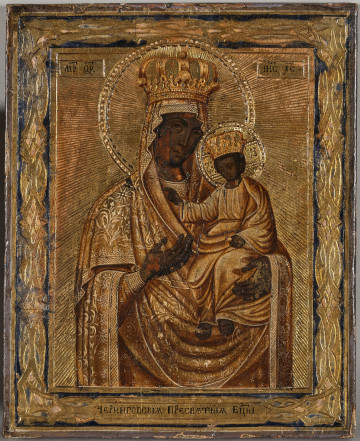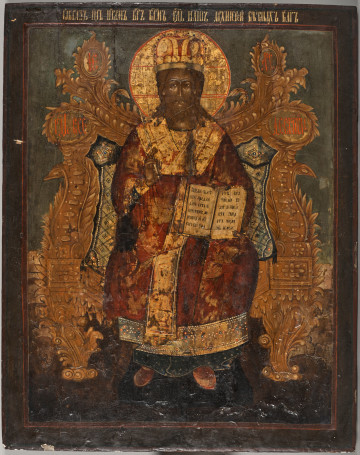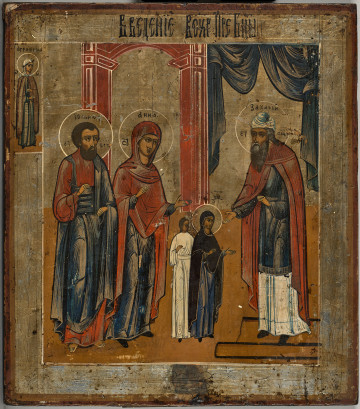
The Mother of God of Hodigitria
19th (?) century
Castle Museum in Łańcut
Part of the collection: Ikony
Christ Pantocrator The Old Testament proscription against creating depictions of the god Yahweh lost some of its importance with the coming of the Son of God. On the pages of the New Testament, Christ is called the Word Incarnate equivalent to the Father, the image of the Invisible God (John 14:9-10; Colossians 1:15). This unity and equivalence justified creating depictions of him. According to the canons of the art of the Eastern Church, God was to be represented exclusively as Christ. The oldest images of the Saviour include depictions of the Omnipotence and the Divine Nature of Christ, called the Almightly, in Greek - Pantocrator. In the 4th-6th c., the Saviour as the Ruler of All began to be portrayed like an earthly ruler, with all the insignia of imperial dignity. There are three variations of this depiction in which Christ is always depicted frontally: the full figure standing, seating on a throne, and, in later iconography, more often as a half-figure, like on the displayed icon. In the cruciform halo surrounding the head of the Saviour, the monogram ΘωΝ was inscribed. This monogram signifies the name of God in Greek and constitutes the equivalent of the Hebrew Yahweh, who called himself ‘I Am That I Am’ when Revealing Himself to Moses. The fingers of the right hand, raised to the level of the chest, are arranged in the form of the monogram IC XC, signifying the name of Christ. The placement of the fingers can, at the same time, be read as a symbol of the dual divine-human nature of the Saviour and the Holy Trinity. The open book in the Saviour's left hand signifies the mission of teaching. On the displayed icon, there are, additionally, scenes related to the Saviours mission. On the left, next to the halo, the depiction of the Holy Trinity as the foretoken of the incarnation of Christ, was shown in the form of three Angels visiting Abraham. The promise of incarnation is fulfilled in the depiction of the birth of Jesus on the right side, by the halo. Below, three key events from the New Testament: the Transfiguration of Christ on Mount Tabor, the Harrowing of Hell, and the Descent of the Holy Spirit on the disciples. Teresa Bagińska-Żurawska https://orcid.org/0000-0002-9243-3967
Dimensions
height: 44.5 cm, width: 38 cm
Object type
Icons
Technique
gilding, tempera
Material
gold, tempera, wood
Origin / acquisition method
decyzja administracyjna
Creation time / dating
Creation / finding place
Owner
Castle Museum in Łańcut
Identification number
Location / status

19th (?) century
Castle Museum in Łańcut

1800 — 1850
Castle Museum in Łańcut

1800 — 1899
Castle Museum in Łańcut
DISCOVER this TOPIC
Museum of King Jan III's Palace at Wilanów
DISCOVER this PATH
Educational path